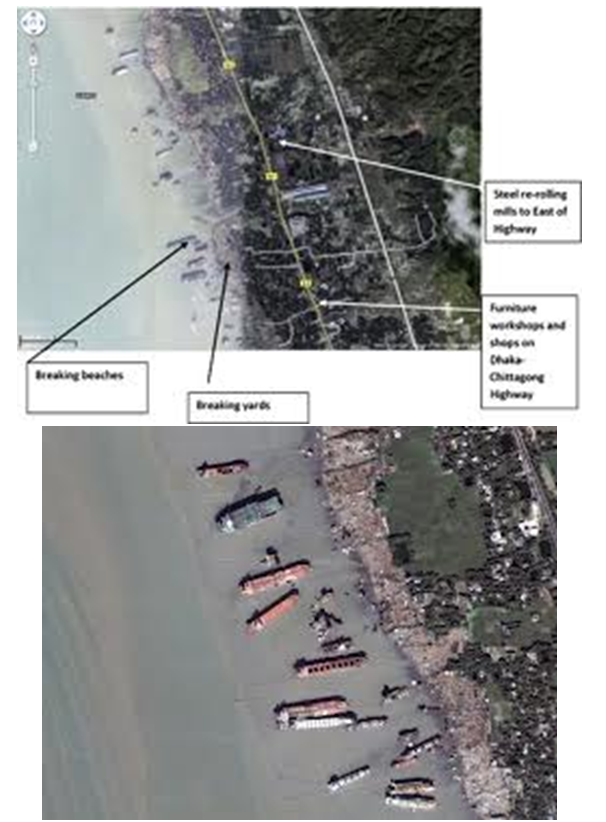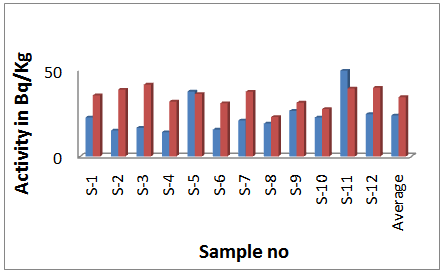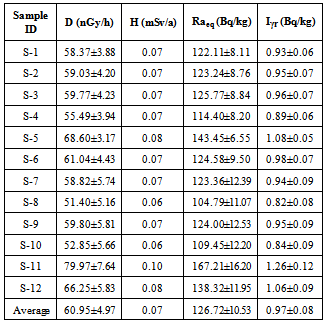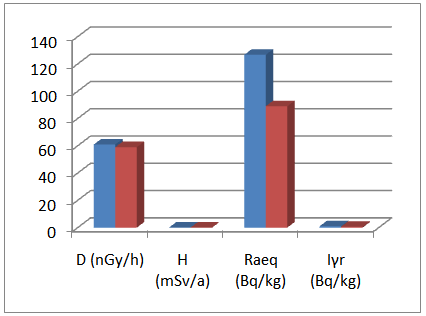QMR Nizam1, SC Nath2, SI Bhuian3, SM Shauddin3, M Kamal3, Ruhul A Khan3, H Ali2
1Department of Physics, University of Chittagong, Chittagong-4331, Bangladesh
2Department of Chemistry, Chittagong Government College, Chittagong
3Radioactivity Testing & Monitoring Laboratory, Bangladesh Atomic Energy Commission, Chittagong
Correspondence to: QMR Nizam, Department of Physics, University of Chittagong, Chittagong-4331, Bangladesh.
| Email: |  |
Copyright © 2012 Scientific & Academic Publishing. All Rights Reserved.
Abstract
The radioactivity of naturally occurring and anthropogenic radionuclides in soil collected from the ship breaking areas VHATIARY SHIP BREAKERS LTD. and ZIAN SHIP BREAKING LTD. Chittagong. Bangladesh, were measured by using gamma spectrum of germanium detector coupled with digital spectrum analyzer (DSA). In the present work, the radioactivity of 238U in soil samples ranged from 49.60±2.14 Bq.kg-1to 14.00± 1.19 Bq.kg-1 with an average value of 23.66±1.55 Bq.kg-1. The activity 232Th ranged from 41.52±5.73 Bq.kg-1 to 22.79±1.42 Bq.kg-1 with an average activity of 34.33±3.57 Bq.kg-1. For 40K, radioactivity ranged from 845.74±76.39 Bq.kg-1 to 620.39±36.91 Bq.kg-1 with an average activity of 702.32±50.34 Bq.kg-1. The activity concentration of 137Cs was not found in any sample at the ship breaking area. It is clear from the experiment that the specific activity of natural radionuclide 40K and radiological hazard parameters like dose rate, radium equivalent activities and representative level index in above mentioned ship breaking areas are high compared with world average and there were no anthropogenic radionuclides present in the investigated ship breaking areas. The finding experimental data of this work would be useful to assess the population exposure from radionuclides in soil as well as base line data of natural radioactivity for the Chittagong ship breaking area.
Keywords:
Environmentalradioactivity, Specific radioactivity, HPGe Gamma-ray spectrometry, Environmental materials, Radium equivalent activity, Gamma absorbed dose rate, Annual effective dose rate
Cite this paper: QMR Nizam, SC Nath, SI Bhuian, SM Shauddin, M Kamal, Ruhul A Khan, H Ali, Radiological Risk Analysis of Soil inside the Ship Breaking Area, Chittagong, Bangladesh, Journal of Nuclear and Particle Physics, Vol. 3 No. 3, 2013, pp. 40-44. doi: 10.5923/j.jnpp.20130303.03.
1. Introduction
The importance of radiation risk caused by natural radioactivity was first underlined in the European Council Directive 96/29EURATOM which set forth basic safety standards for the protection of the health of workers and the general public against the danger arising from ionizing radiation. Since this directive came into effect, a lot of research on this matter has been carried out. The occupational hazards in some Naturally Occurring Radioactive Material (NORM) have been quite well-identified[1]. However, the use of anthropogenic radioactivity standards, which were clearly defined in a regulatory context often ignored the natural causes of radioactivity or assessed them on a case by case basis resulting in the substantial understatement of the risk from those other sources of radiation. Finally, the potential detrimental effect on the environment of NORM is rarely taken into consideration when an environmental risk assessment (ERA) is carried out[2]. The present trend of environmental radioactivity study has come forward to save human life from the effects of atomic radiation originating from NORM and anthropogenic radionuclides of nuclear activities. Natural environmental radioactivity and the associated external exposure due to gamma radiation depend primarily on the geological and geographical conditions, and appear at different levels in the soils of each region in the world [4, 5, 6]. It is important to make studies on distribution of various radionuclides present in the soil and the different factors that distribute the various radionuclides from soil to food chain and their subsequent transfer to the human body. So, for the assessment of radiation hazard in Bangladesh, it is essential to determine the concentration of terrestrial radionuclides throughout the country. As a part of it, this study was conducted at the ship breaking yards. Ship breaking activities in Bangladesh is concentrated in Sitakund (Bhatiary to Barwalia), just north of Chittagong city on the Bay of Bengal. It is of paramount importance to the macro and micro economies of poverty stricken Bangladesh. Ship breaking activities present both challenges and opportunities for our coastal zone management. Meeting the increasing demand for raw materials such as steel needs to be balanced with the negative impact this nag on our coastal environment and the conditions of the workers. On average 180-250 old ships each year are scrapped in about 30 ship breaking yards located in this coast. Around 200,000 people are engaged in different business related to the ship breaking activity. This research work found out the distribution of different radionuclides in soil of these ship breaking yards and thereby assessed the radiation hazard. So, this work will be valuable in the development of rules and regulation for the health and environmental safety in the ship breaking industry.
2. Materials and Methods
2.1. Sample Collection and Preparation
In order to determine the radioactivity of naturally occurring and anthropogenic radionuclides in the soil, a total number of 12 samples were collected from Ship Breaking Area, Chittagong, Bangladesh. All samples were collected from two yards, ZIAN SHIP BREAKING LTD. and VHATIARY SHIP BREAKERS LTD. Intervel and the locations are shown in the Figure-1.  | Figure 1. Goggle map shows the ship breaking yard from where the samples were collected |
All the solid and powdered samples were air dried under laboratory temperature. All solid samples were cleaned and dried at about 120oC in the electric oven for about 24 hours to remove added moisture and thereafter crushed to fine powder with mortar and pestle. Each of the samples was transferred to sealed cylindrical plastic container of diameter 7 cm and 3.5 cm in height, marked individually with identification parameter such as name and the location of the sample, date of preparation and net weight. All the samples containers were sealed tightly with cap and wrapped with Teflon and thick vinyl tapes inside and outside around their screw necks and finally air tightened with polythene pack and stored for minimum four weeks to allow for the attainment of secular equilibrium between the long lived 238U and 232Th and their short lived progeny [7,8].
2.2. Radioactive Analysis of Soil Samples
Since most of the radio-nuclides are gamma emitters, gamma spectroscopy can reveal dominant sources of radioactivity. A high purity germanium (HPGe) detector was used to record the gamma ray emissions from the soil samples. This gamma detector was coupled with a digital spectrum analyzer, DSA-1000, which provided a full featured multichannel analyzer of 16K channel based on digital signal processing techniques. Canberra’s Genie-2000 spectroscopy software was used to record and analyze the gamma ray spectra of soil samples. Determination of counting efficiency and calibration were done by using the standard samples provided by the International Atomic Energy Commission (IAEA); these reference samples were RGU‐1 for 238U series, RGTh‐1 for ²³²Th series, RGK‐1 for ⁴⁰K and IAEA‐152 for ¹³⁷Cs. Figure-2 shows the energy efficiency curve: | Figure 2. Energy efficiency curve of HPGe detector |
The detector was placed inside a massive lead shield in order to reduce the background radiation. After adjustment of the necessary parameters such as resolution, peak to Compton ratio etc, and measurement of minimum detectable activity of the detector, each of the collected samples were placed on the top of the detector within the shielding arrangement [9]. Moreover, a background spectrum was recorded for 20,000 seconds for a blank sample container of the same geometry of the detector. This background reading was subtracted from the sample reading to determine the net count originated from the sample [7]. Gamma spectrum for each soil and reference sample was also recorded for 20,000 seconds. Since each soil sample was kept hermetically for more than one month, analysis of gamma spectrum was done on the assumption of secular equilibrium state in ²³⁸U and ²³²Th series. Activity of 238U radionuclide was determined from the observed counts at gamma energies 241.98 keV, 295.21 keV and 351.92 keV emitted by the daughter nuclide ²¹⁴Pb and also at energies 609.31 keV, 1120.29 keV and 1764.49 keV emitted by the another daughter ²¹⁴Bi. For the radionuclide ²³²Th, counts at energies 238.63 keV of ²¹²Pb, 338.40 keV, 911.07 keV and 969.11 keV of ²²⁸Ac and 583.19 of ²⁰⁸Tl were used. Gamma peaks at energies 1460.75 keV and 661.66 keV, respectively, were used for the determination of activities of ⁴⁰K and ¹³⁷Cs. Then the activities were calculated by using the formula: | (1) |
Where,CPS = Net counts per second % Eff. = Efficiency of the gamma energy.I =Intensity of the measured gamma from the radio-nuclide.
3. Results and Discussion
3.1. Activity Concentrations
Table 1. The activity concentrations of natural radionuclides 238U, ²³²Th and ⁴⁰K in the soil samples
 |
| |
|
 | Figure 3. Activity concentration of U-238 and Th-232 in different soil sample |
The measured activity concentrations of natural radionuclides 238U, ²³²Th and ⁴⁰K in the soil samples are given in Table-1. The study shows that the highest activity of 238U was found to be 49.60±2.14Bq.kg-1 in sample no- 11, lowest in sample no-4, was 14.00±1.33 Bq.kg-1 with an average activity of 23.66±1.55 Bq.kg-1. The highest activity of 232Th was found to be 41.52±5.73 Bq.kg-1 in sample no- 03, lowest in sample no- 8, was 22.79±1.42 Bq.kg-1 with an average activity of 34.33±3.57 Bq.kg-1. The highest activity of 40K was found 845.74±76.39 Bq.kg-1 in sample no-06, lowest in sample no-10, was 620.39±36.91 Bq.kg-1 with an average activity of 702.32±50.34 Bq.kg-1. And figure-3 represents the activity concentration of 238U and 232Th in different soil sample. Figure -4 compare the measured values of natural radionuclides with world average values. | Figure 4. Comparison of natural radionuclides with world average values |
3.2. Radiation Hazard Parameters
3.2.1. The outdoor gamma ray exposure rate in air at one meter height above the ground due to natural radionuclides in soils was calculated by the following formula [3]:  | (2) |
Where, AU, ATh, and AK are the average activity concentrations of 238U, 232Th and 40K, respectively in soils in units of Bq/kg. This dose rate is found in the range of 79.97±7.64 nGyh-1 to 51.40±3.17 nGyh-1 with an average of 60.95±4.97 nGyh-1 which is greater than the world value 59 nGyh-1[11].3.2.2. To estimate the annual effective dose rates, the conversion coefficient from absorbed dose rate in air (Dair) to effective dose (0.7) and outdoor occupancy factor (0.2) proposed by UNSCEAR (2008) were used. The effective dose rate (mSv/a) was calculated using the formula [12]: | (3) |
The resulting average of annual effective dose is 0.07±0.01 mSv/a with ranges from 0.10±0.01 mSv/a to 0.06±0.001 mSv/a. while the world average annual effective dose is 0.07 mSv/a [11].3.2.3. For the estimation of radiation hazards due to natural radio-nuclides it is now common practice to calculate the radium equivalent activity (Raeq) and representative level index (Iγr) using the following equation[13]: | (4) |
 | (5) |
Table 2. The values of outdoor dose rate, annual effective dose, radium equivalent activities and representative level index in smples
 |
| |
|
Table 3. Comparison of results of the present study with corresponding world average values worldwide value and regional study
 |
| |
|
 | Figure 5. Comparison of radiological hazard parameters values with world average value |
Table 4. Comparison of the measured mean specific activities of natural radionuclides in soil samples with the values reported for various countries in literature
 |
| |
|
Where AU , ATh and AK are the specific activities of 238U, 232Th and 40K ( in Bq.kg-1 ) respectively . The resulting average of radium equivalent activity (Raeq) is 126.72±10.53 BqKg-1 with ranges from 167.21±16.20 BqKg-1 to 104.78±6.55 BqKg-1. And the resulting average of representative level index (Iγr) is 0.97 BqKg-1 with ranges from 1.26 BqKg-1 to 0.82 BqKg-1. The above values for each sample are shown in the table-2 given below. And comparisons of these values with world average as well as regional study and with other countries are shown in figure-5, table-3 and table-4 respectively.
4. Conclusions
The activity concentrations of natural radionuclides 238U, ²³²Th and ⁴⁰K in the soil samples are 23.66±1.55 Bq.kg-1, 34.33±3.57 Bq.kg-1 and 702.32±50.34 Bq.kg-1. Present study shows that the activity concentrations of 40K are greater than the value of the world average (412 Bq.kg-1 for 40K) [3]. Also the value of outdoor dose rate, radium equivalent activities and representative level index are higher than the world average value. There are no fallout radionuclides 137Cs. The increasing trend of 40K is due to the presence of loamy and clay sediments [19] and may be due to the high content of monazite [20].The obtained data cover a wide area in ship breaking area of Chittagong. The mean concentrations of the radionuclides 238U, 232Th and 40K in soil samples determined in this study compare suitably with literature values. But the 137Cs activity concentrations of all places are below the detectable range. This study can be used as a baseline for future investigations and the data obtained in this study may be useful for natural radioactivity mapping. It seems necessary to determine the radioactivity concentrations in soils and sediments of other parts of Chittagong, Bangladesh. The results may also be used as a reference data for monitoring possible radioactivity pollutions in future.
ACKNOWLEDGEMENTS
Authors are grateful to M. Kamal, director of the Radioactivity Testing and Monitoring Laboratory, Chittagong for his valuable suggestions in this study.
References
| [1] | IAEA: Extent of environmental contamination by naturally occurring radioactive material (NORM) and technological options for mitigation. Technical Reports Series No. 4I9, 2003. |
| [2] | IAEA , Measurement of Radionuclides in Food & the Environment, A guide book, Technical Report Series No. 295, IAEA, Vienna, 1989. |
| [3] | UNSCEAR (B), 2008: Sources and Effects of Ionizing Radiation, Annex B: Exposures of the public and workers from various sources of radiation. United Nations Scientific Committee on the effects of Atomic Radiation, New York, 2010. |
| [4] | Iqbal, M., Tufail, M. and Mirza, S.M., Measurement of Natural Radioactivity in Marble Found in Pakistan Using a NaI(Tl) Gamma-Ray Spectrometer. Technical Note, Journal of Environmental Radioactivity, 51(2), 255–265, 2000. |
| [5] | Anagnostakis, M.J., Hinis, E.P., Simopoulos, S.E. and Angelopoulos, M.G. NaturalRadioactivity Mapping of Greek Surface Soils. Environmental International, 22 (1), 3–8, 1996. |
| [6] | Shender, M.A., Measurement of Natural Radioactivity Levels in Soil in Tripoli. Applied Radiation and Isotopes, 48 (1), 147–148, 1997, |
| [7] | Debertin, K., Helmer, R.G., Gamma and X-ray Spectrometry with Semiconductor Detectors, Elsevier, Amsterdam, 1980. |
| [8] | Schotzig, U., Debertin, K., Photon emission probabilities per decay of 226Ra and 232Th in equilibrium with their daughter product,. Appl. Radiat. Isot. 34, 533-538, 1983. |
| [9] | Knoll, G.F., Radiation detection and measurement. John Willey and Sons, 1989. |
| [10] | Beretka, J., Mathew, P. J., Natural radioactivity of Australian building materials, industrial wastes and by products. Health Phys. 48, 87-95, 1985. |
| [11] | UNSCEAR-2000: (United Nations Scientific Committee on the Effects of Atomic Radiation). “Sources and biological effects of ionizing radiation”, Annex B: Exposures from Natural Radiation Sources”. 2010, New York. |
| [12] | Cutshall, N. H., Larsen, I. L. and Olesen, C. R. Direct analysis of 214Pb in sediment samples: self-absorption correction,. Nucl. Instrum. Methods Phys. Res. 206(1–2) 309–312 (1983). |
| [13] | Hamid, B. N., Chowdhury, M. I., Alam, M. N. and Islam, M. N. Study of natural radionuclide concentrations in an area of elevated radiation background in the Northern districts of Bangladesh, Radiat. Prot. Dosimetry 98(2) 227–230 (2002). |
| [14] | UNSCEAR (United Nations Scientific Committee on the Effects of Atomic Radiation). Exposure from natural sources of radiation. Report to the General Assembly with annexes. (1988). |
| [15] | Chowdhury, M. I., Alam, M. N. and Hazari, S. K. S. Distribution of radionuclides in the river sediments and coastal soils of Chittagong Bangladesh and evaluation of the radiation hazard, Appl. Radiat. Isot. 51(6) 747–755 (1999). |
| [16] | Mohammad Kamal Hossain, Syed Mohammod Hossain, Rezaul Azim, AKM Moinul Haque Meaze, Assessment of radiological contamination of soils due to shipbreaking using HPGe digital gamma-ray spectrometry system, J. Environ. Protect. 1, 10-14, 2010. |
| [17] | Mia, F.K., Roy, S., Touhiduzzaman, N., Alan, B. Distribution of radionuclides in soil samples in and around Dhaka city. Appl. Radiat. Isot. 49, 133-137. 1998. |
| [18] | Rahman M. M. et al“Radiation hazards due to terrestrial radionuclides at the coastal area of Ship Breaking Industries, Sitakunda, Bangladesh”, Science Journal of Physics, volume-2, issue-2, 2012. |
| [19] | El-Gamel, A., S. Nasar and A. El-Taher: “Study of the spatial distribution of natural radioactivity in upper Egypt Nile riversediments”. Radiation measurement, 42, 457-465. 2007. |
| [20] | Orgun, Y., N. Altinsoy, S. Y. Sahin, y. Gungor, A. H. Gultekin, G. Karahan,and Z. Karaak (2007): “Natural and anthropogenic radionuclides in rocks and beach sands from Ezine region (Canakkall) Western Anatolia, Turkey”. Appl. Radiat. Isot, 65, 739-747, 2007. |











 Abstract
Abstract Reference
Reference Full-Text PDF
Full-Text PDF Full-text HTML
Full-text HTML


